sensor FORD SIERRA 1990 2.G CVH Engines Workshop Manual
[x] Cancel search | Manufacturer: FORD, Model Year: 1990, Model line: SIERRA, Model: FORD SIERRA 1990 2.GPages: 24, PDF Size: 1.09 MB
Page 6 of 24

a)Removal of the cylinder head
b)Removal of the camshaft
c)Removal of the timing belt and sprockets
d)Removal of the engine mountings
e)Removal of the clutch and flywheel
f)Removal of the crankshaft oil seals
a)Removal of the sump
b)Removal of the oil pump
c)Removal of the pistons/connecting rods
d)Removal of the big-end bearings
e)Removal of the crankshaft main bearings
f)Removal of the crankshaft
Refer to Section 8, Chapter 2, Part A.
Note: A suitable hoist and lifting tackle will be
required for this operation.
1.8 litre (R2A type)
1Disconnect the battery negative lead.
2Remove the bonnet.
3Remove the air cleaner.
4Disconnect the cooling fan wiring plug, then
unscrew the retaining nuts and washers and
withdraw the fan shroud and cooling fan
assembly.
5Drain the cooling system.
6Disconnect the coolant hoses from the
coolant pump elbow, and detach the heater
hose from the clip on the front of the timing
cover.
7Disconnect the upper radiator hose and the
expansion tank hose from the thermostat
housing (see illustration).8Disconnect the heater hose from the
automatic choke.
9Disconnect the brake servo vacuum hose
from the inlet manifold (see illustration).
10Disconnect the throttle damper solenoid
vacuum pipes (noting their locations) from the
throttle damper and the carburettor “T”-piece
connector.
11Disconnect the engine management
module vacuum pipe from the inlet manifold.
12Disconnect the fuel hoses from the
carburettor and fuel pump, and plug the ends
of the hoses to minimise petrol spillage. Take
adequate fire precautions.
13Disconnect the throttle cable.
14Disconnect the HT leads from the coil and
spark plugs, unclip the leads from the
camshaft cover, and remove the distributor
cap, rotor arm and housing.
15Disconnect the wiring from the following
components:
Alternator
Starter motor
Oil pressure warning lamp switch
Temperature gauge sender
Engine coolant temperature sensor
Automatic choke
Cooling fan switch
Crankshaft speed/position sensor
Engine earth strap to battery tray16Unscrew and remove the top engine-to-
gearbox bolts which are accessible from the
engine compartment.
17Apply the handbrake (if not already done),
jack up the front of the vehicle and support on
axle stands (see “Jacking and Vehicle
Support”).
18Drain the engine oil into a container.
19Remove the starter motor.
20Remove the exhaust downpipe.
21Unscrew the two nuts securing the engine
mountings to the crossmember. Recover the
washers.
22Unscrew and remove the remaining
engine-to-gearbox bolts, noting the location
of the earth strap (see illustration), and
remove the two bolts from the engine adapter
plate (see illustration).
23Working inside the vehicle, place a
wooden block under the clutch pedal to raise
it fully against its stop which will hold the
automatic adjuster pawl clear of the toothed
quadrant.
24Disconnect the clutch cable from the
release arm, and pass the cable through the
bellhousing. Remove the clip securing the
clutch cable to the right-hand engine
mounting bracket. Note the cable routing for
use when refitting.
25Lower the vehicle to the ground, and
support the gearbox with a trolley jack using a
block of wood between the jack and the
gearbox to spread the load.
26Make a final check to ensure that all
relevant wires, pipes and hoses have been
disconnected to facilitate engine removal.
27Attach a suitable hoist to the engine lifting
brackets located at the front and rear of the
cylinder head, and carefully take the weight of
the engine. The engine should be supported
horizontally, ie do not allow it to tilt front to
rear.
28Raise the engine until the engine
mounting studs are clear of the crossmember,
then pull the engine forwards to disconnect it
from the gearbox. Ensure that the gearbox is
adequately supported, and take care not to
strain the gearbox input shaft. It may be
necessary to rock the engine a little to release
it from the gearbox.
8Engine - removal leaving
manual gearbox in vehicle
7Method of engine removal
6Major operations requiring
engine removal
5Major operations possible with
the engine in the vehicle
2C•6CVH engines
8.9 Disconnecting the brake servo vacuum
hose from the inlet manifold -
1.8 litre (R2A)
8.22b Remove the two bolts (arrowed) from
the engine adapter plate - 1.8 litre (R2A)8.22a Earth strap location under engine-to-
gearbox bolt - 1.8 litre (R2A)
8.7 Disconnect the upper radiator hose (1)
and the expansion tank hose (2) from the
thermostat housing - 1.8 litre (R2A)
Page 7 of 24
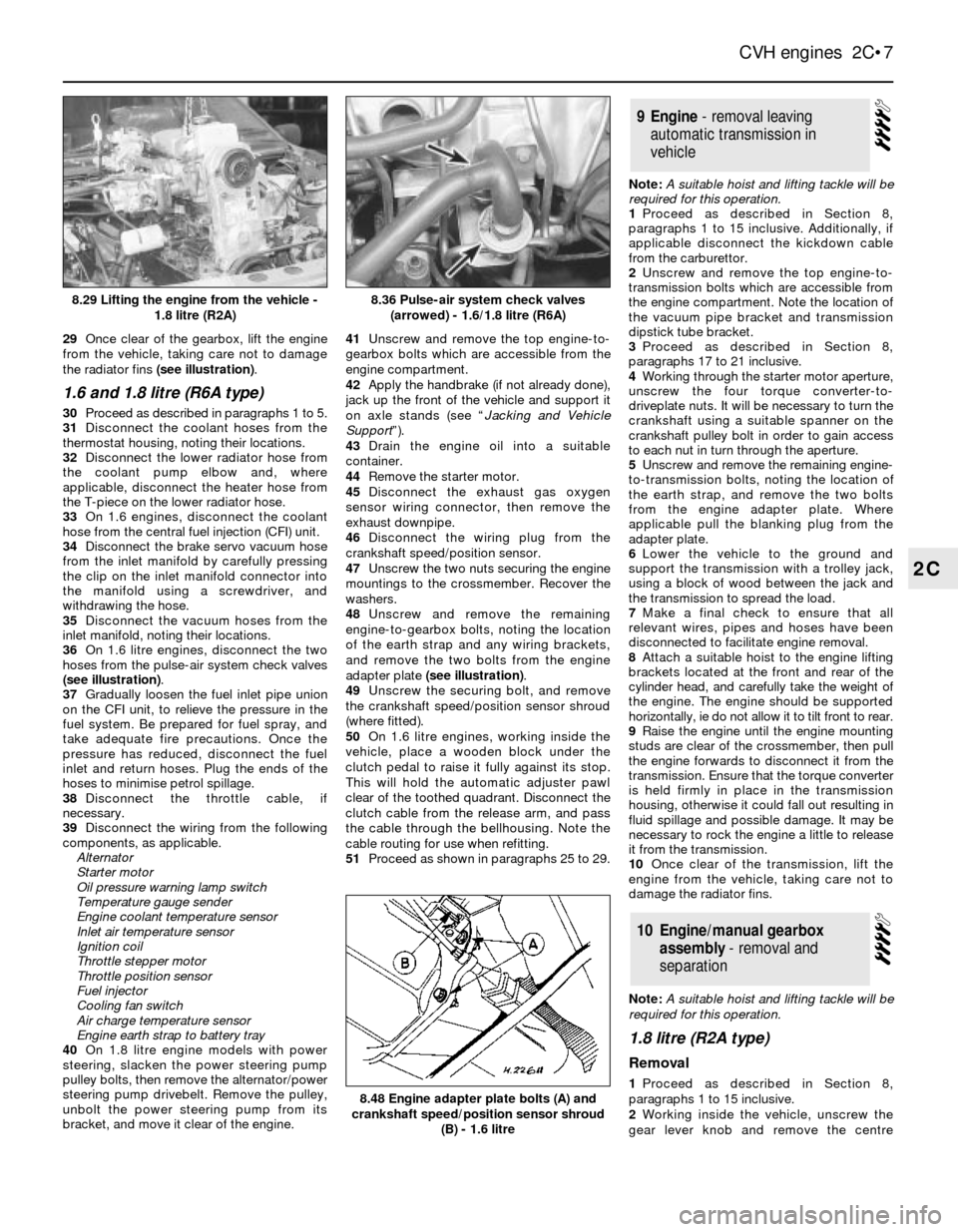
29Once clear of the gearbox, lift the engine
from the vehicle, taking care not to damage
the radiator fins (see illustration).
1.6 and 1.8 litre (R6A type)
30Proceed as described in paragraphs 1 to 5.
31Disconnect the coolant hoses from the
thermostat housing, noting their locations.
32Disconnect the lower radiator hose from
the coolant pump elbow and, where
applicable, disconnect the heater hose from
the T-piece on the lower radiator hose.
33On 1.6 engines, disconnect the coolant
hose from the central fuel injection (CFI) unit.
34Disconnect the brake servo vacuum hose
from the inlet manifold by carefully pressing
the clip on the inlet manifold connector into
the manifold using a screwdriver, and
withdrawing the hose.
35Disconnect the vacuum hoses from the
inlet manifold, noting their locations.
36On 1.6 litre engines, disconnect the two
hoses from the pulse-air system check valves
(see illustration).
37Gradually loosen the fuel inlet pipe union
on the CFI unit, to relieve the pressure in the
fuel system. Be prepared for fuel spray, and
take adequate fire precautions. Once the
pressure has reduced, disconnect the fuel
inlet and return hoses. Plug the ends of the
hoses to minimise petrol spillage.
38Disconnect the throttle cable, if
necessary.
39Disconnect the wiring from the following
components, as applicable.
Alternator
Starter motor
Oil pressure warning lamp switch
Temperature gauge sender
Engine coolant temperature sensor
Inlet air temperature sensor
Ignition coil
Throttle stepper motor
Throttle position sensor
Fuel injector
Cooling fan switch
Air charge temperature sensor
Engine earth strap to battery tray
40On 1.8 litre engine models with power
steering, slacken the power steering pump
pulley bolts, then remove the alternator/power
steering pump drivebelt. Remove the pulley,
unbolt the power steering pump from its
bracket, and move it clear of the engine.41Unscrew and remove the top engine-to-
gearbox bolts which are accessible from the
engine compartment.
42Apply the handbrake (if not already done),
jack up the front of the vehicle and support it
on axle stands (see “Jacking and Vehicle
Support”).
43Drain the engine oil into a suitable
container.
44Remove the starter motor.
45Disconnect the exhaust gas oxygen
sensor wiring connector, then remove the
exhaust downpipe.
46Disconnect the wiring plug from the
crankshaft speed/position sensor.
47Unscrew the two nuts securing the engine
mountings to the crossmember. Recover the
washers.
48Unscrew and remove the remaining
engine-to-gearbox bolts, noting the location
of the earth strap and any wiring brackets,
and remove the two bolts from the engine
adapter plate (see illustration).
49Unscrew the securing bolt, and remove
the crankshaft speed/position sensor shroud
(where fitted).
50On 1.6 litre engines, working inside the
vehicle, place a wooden block under the
clutch pedal to raise it fully against its stop.
This will hold the automatic adjuster pawl
clear of the toothed quadrant. Disconnect the
clutch cable from the release arm, and pass
the cable through the bellhousing. Note the
cable routing for use when refitting.
51Proceed as shown in paragraphs 25 to 29.Note: A suitable hoist and lifting tackle will be
required for this operation.
1Proceed as described in Section 8,
paragraphs 1 to 15 inclusive. Additionally, if
applicable disconnect the kickdown cable
from the carburettor.
2Unscrew and remove the top engine-to-
transmission bolts which are accessible from
the engine compartment. Note the location of
the vacuum pipe bracket and transmission
dipstick tube bracket.
3Proceed as described in Section 8,
paragraphs 17 to 21 inclusive.
4Working through the starter motor aperture,
unscrew the four torque converter-to-
driveplate nuts. It will be necessary to turn the
crankshaft using a suitable spanner on the
crankshaft pulley bolt in order to gain access
to each nut in turn through the aperture.
5Unscrew and remove the remaining engine-
to-transmission bolts, noting the location of
the earth strap, and remove the two bolts
from the engine adapter plate. Where
applicable pull the blanking plug from the
adapter plate.
6Lower the vehicle to the ground and
support the transmission with a trolley jack,
using a block of wood between the jack and
the transmission to spread the load.
7Make a final check to ensure that all
relevant wires, pipes and hoses have been
disconnected to facilitate engine removal.
8Attach a suitable hoist to the engine lifting
brackets located at the front and rear of the
cylinder head, and carefully take the weight of
the engine. The engine should be supported
horizontally, ie do not allow it to tilt front to rear.
9Raise the engine until the engine mounting
studs are clear of the crossmember, then pull
the engine forwards to disconnect it from the
transmission. Ensure that the torque converter
is held firmly in place in the transmission
housing, otherwise it could fall out resulting in
fluid spillage and possible damage. It may be
necessary to rock the engine a little to release
it from the transmission.
10Once clear of the transmission, lift the
engine from the vehicle, taking care not to
damage the radiator fins.
Note: A suitable hoist and lifting tackle will be
required for this operation.
1.8 litre (R2A type)
Removal
1Proceed as described in Section 8,
paragraphs 1 to 15 inclusive.
2Working inside the vehicle, unscrew the
gear lever knob and remove the centre
10Engine/manual gearbox
assembly - removal and
separation
9Engine - removal leaving
automatic transmission in
vehicle
CVH engines 2C•7
2C
8.48 Engine adapter plate bolts (A) and
crankshaft speed/position sensor shroud
(B) - 1.6 litre
8.36 Pulse-air system check valves
(arrowed) - 1.6/1.8 litre (R6A)8.29 Lifting the engine from the vehicle -
1.8 litre (R2A)
Page 8 of 24
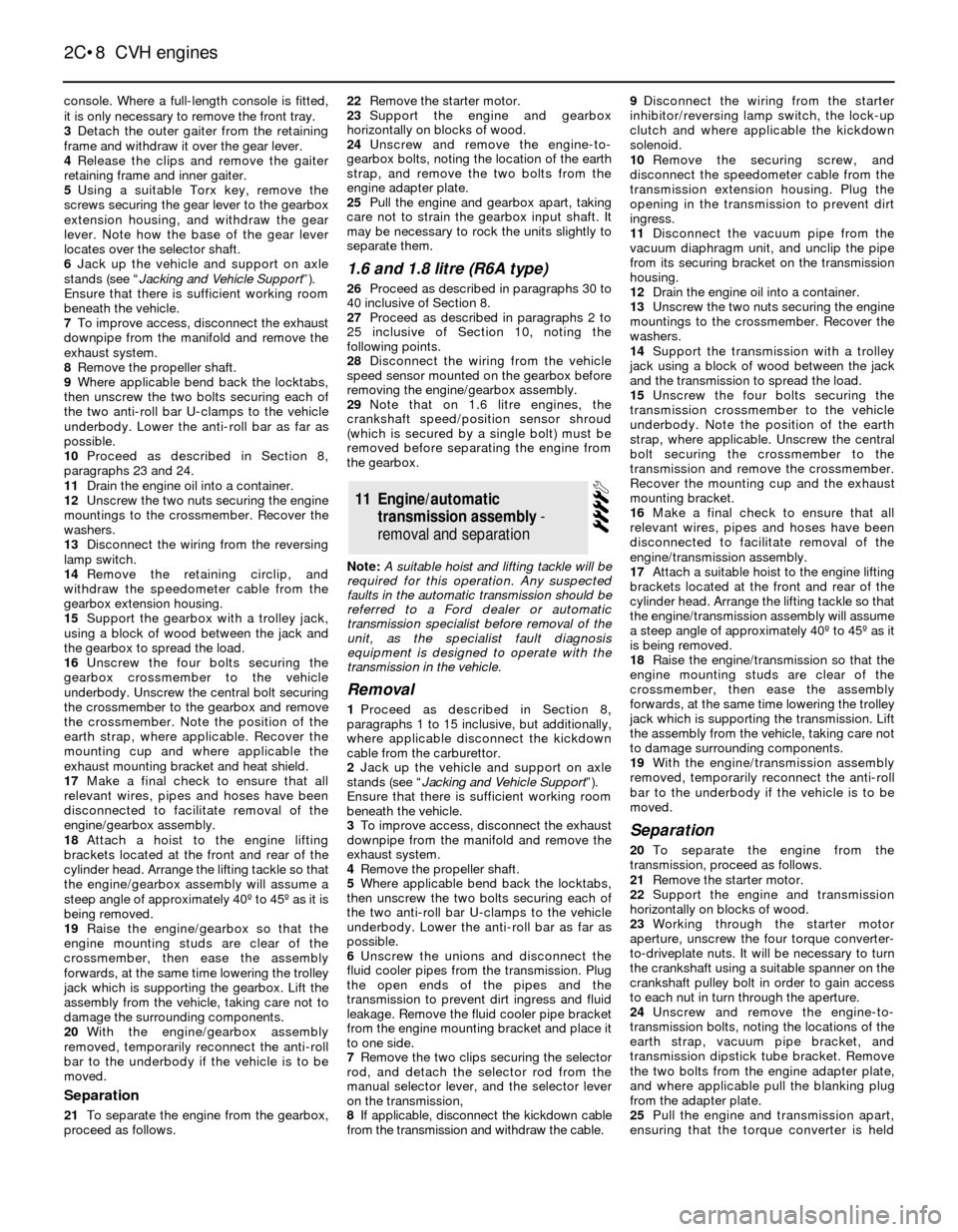
console. Where a full-length console is fitted,
it is only necessary to remove the front tray.
3Detach the outer gaiter from the retaining
frame and withdraw it over the gear lever.
4Release the clips and remove the gaiter
retaining frame and inner gaiter.
5Using a suitable Torx key, remove the
screws securing the gear lever to the gearbox
extension housing, and withdraw the gear
lever. Note how the base of the gear lever
locates over the selector shaft.
6Jack up the vehicle and support on axle
stands (see “Jacking and Vehicle Support”).
Ensure that there is sufficient working room
beneath the vehicle.
7To improve access, disconnect the exhaust
downpipe from the manifold and remove the
exhaust system.
8Remove the propeller shaft.
9Where applicable bend back the locktabs,
then unscrew the two bolts securing each of
the two anti-roll bar U-clamps to the vehicle
underbody. Lower the anti-roll bar as far as
possible.
10Proceed as described in Section 8,
paragraphs 23 and 24.
11Drain the engine oil into a container.
12Unscrew the two nuts securing the engine
mountings to the crossmember. Recover the
washers.
13Disconnect the wiring from the reversing
lamp switch.
14Remove the retaining circlip, and
withdraw the speedometer cable from the
gearbox extension housing.
15Support the gearbox with a trolley jack,
using a block of wood between the jack and
the gearbox to spread the load.
16Unscrew the four bolts securing the
gearbox crossmember to the vehicle
underbody. Unscrew the central bolt securing
the crossmember to the gearbox and remove
the crossmember. Note the position of the
earth strap, where applicable. Recover the
mounting cup and where applicable the
exhaust mounting bracket and heat shield.
17Make a final check to ensure that all
relevant wires, pipes and hoses have been
disconnected to facilitate removal of the
engine/gearbox assembly.
18Attach a hoist to the engine lifting
brackets located at the front and rear of the
cylinder head. Arrange the lifting tackle so that
the engine/gearbox assembly will assume a
steep angle of approximately 40º to 45º as it is
being removed.
19Raise the engine/gearbox so that the
engine mounting studs are clear of the
crossmember, then ease the assembly
forwards, at the same time lowering the trolley
jack which is supporting the gearbox. Lift the
assembly from the vehicle, taking care not to
damage the surrounding components.
20With the engine/gearbox assembly
removed, temporarily reconnect the anti-roll
bar to the underbody if the vehicle is to be
moved.
Separation
21To separate the engine from the gearbox,
proceed as follows. 22Remove the starter motor.
23Support the engine and gearbox
horizontally on blocks of wood.
24Unscrew and remove the engine-to-
gearbox bolts, noting the location of the earth
strap, and remove the two bolts from the
engine adapter plate.
25Pull the engine and gearbox apart, taking
care not to strain the gearbox input shaft. It
may be necessary to rock the units slightly to
separate them.
1.6 and 1.8 litre (R6A type)
26Proceed as described in paragraphs 30 to
40 inclusive of Section 8.
27Proceed as described in paragraphs 2 to
25 inclusive of Section 10, noting the
following points.
28Disconnect the wiring from the vehicle
speed sensor mounted on the gearbox before
removing the engine/gearbox assembly.
29Note that on 1.6 litre engines, the
crankshaft speed/position sensor shroud
(which is secured by a single bolt) must be
removed before separating the engine from
the gearbox.
Note: A suitable hoist and lifting tackle will be
required for this operation. Any suspected
faults in the automatic transmission should be
referred to a Ford dealer or automatic
transmission specialist before removal of the
unit, as the specialist fault diagnosis
equipment is designed to operate with the
transmission in the vehicle.
Removal
1Proceed as described in Section 8,
paragraphs 1 to 15 inclusive, but additionally,
where applicable disconnect the kickdown
cable from the carburettor.
2Jack up the vehicle and support on axle
stands (see “Jacking and Vehicle Support”).
Ensure that there is sufficient working room
beneath the vehicle.
3To improve access, disconnect the exhaust
downpipe from the manifold and remove the
exhaust system.
4Remove the propeller shaft.
5Where applicable bend back the locktabs,
then unscrew the two bolts securing each of
the two anti-roll bar U-clamps to the vehicle
underbody. Lower the anti-roll bar as far as
possible.
6Unscrew the unions and disconnect the
fluid cooler pipes from the transmission. Plug
the open ends of the pipes and the
transmission to prevent dirt ingress and fluid
leakage. Remove the fluid cooler pipe bracket
from the engine mounting bracket and place it
to one side.
7Remove the two clips securing the selector
rod, and detach the selector rod from the
manual selector lever, and the selector lever
on the transmission,
8If applicable, disconnect the kickdown cable
from the transmission and withdraw the cable.9Disconnect the wiring from the starter
inhibitor/reversing lamp switch, the lock-up
clutch and where applicable the kickdown
solenoid.
10Remove the securing screw, and
disconnect the speedometer cable from the
transmission extension housing. Plug the
opening in the transmission to prevent dirt
ingress.
11Disconnect the vacuum pipe from the
vacuum diaphragm unit, and unclip the pipe
from its securing bracket on the transmission
housing.
12Drain the engine oil into a container.
13Unscrew the two nuts securing the engine
mountings to the crossmember. Recover the
washers.
14Support the transmission with a trolley
jack using a block of wood between the jack
and the transmission to spread the load.
15Unscrew the four bolts securing the
transmission crossmember to the vehicle
underbody. Note the position of the earth
strap, where applicable. Unscrew the central
bolt securing the crossmember to the
transmission and remove the crossmember.
Recover the mounting cup and the exhaust
mounting bracket.
16Make a final check to ensure that all
relevant wires, pipes and hoses have been
disconnected to facilitate removal of the
engine/transmission assembly.
17Attach a suitable hoist to the engine lifting
brackets located at the front and rear of the
cylinder head. Arrange the lifting tackle so that
the engine/transmission assembly will assume
a steep angle of approximately 40º to 45º as it
is being removed.
18Raise the engine/transmission so that the
engine mounting studs are clear of the
crossmember, then ease the assembly
forwards, at the same time lowering the trolley
jack which is supporting the transmission. Lift
the assembly from the vehicle, taking care not
to damage surrounding components.
19With the engine/transmission assembly
removed, temporarily reconnect the anti-roll
bar to the underbody if the vehicle is to be
moved.
Separation
20To separate the engine from the
transmission, proceed as follows.
21Remove the starter motor.
22Support the engine and transmission
horizontally on blocks of wood.
23Working through the starter motor
aperture, unscrew the four torque converter-
to-driveplate nuts. It will be necessary to turn
the crankshaft using a suitable spanner on the
crankshaft pulley bolt in order to gain access
to each nut in turn through the aperture.
24Unscrew and remove the engine-to-
transmission bolts, noting the locations of the
earth strap, vacuum pipe bracket, and
transmission dipstick tube bracket. Remove
the two bolts from the engine adapter plate,
and where applicable pull the blanking plug
from the adapter plate.
25Pull the engine and transmission apart,
ensuring that the torque converter is held
11Engine/automatic
transmission assembly -
removal and separation
2C•8CVH engines
Page 9 of 24
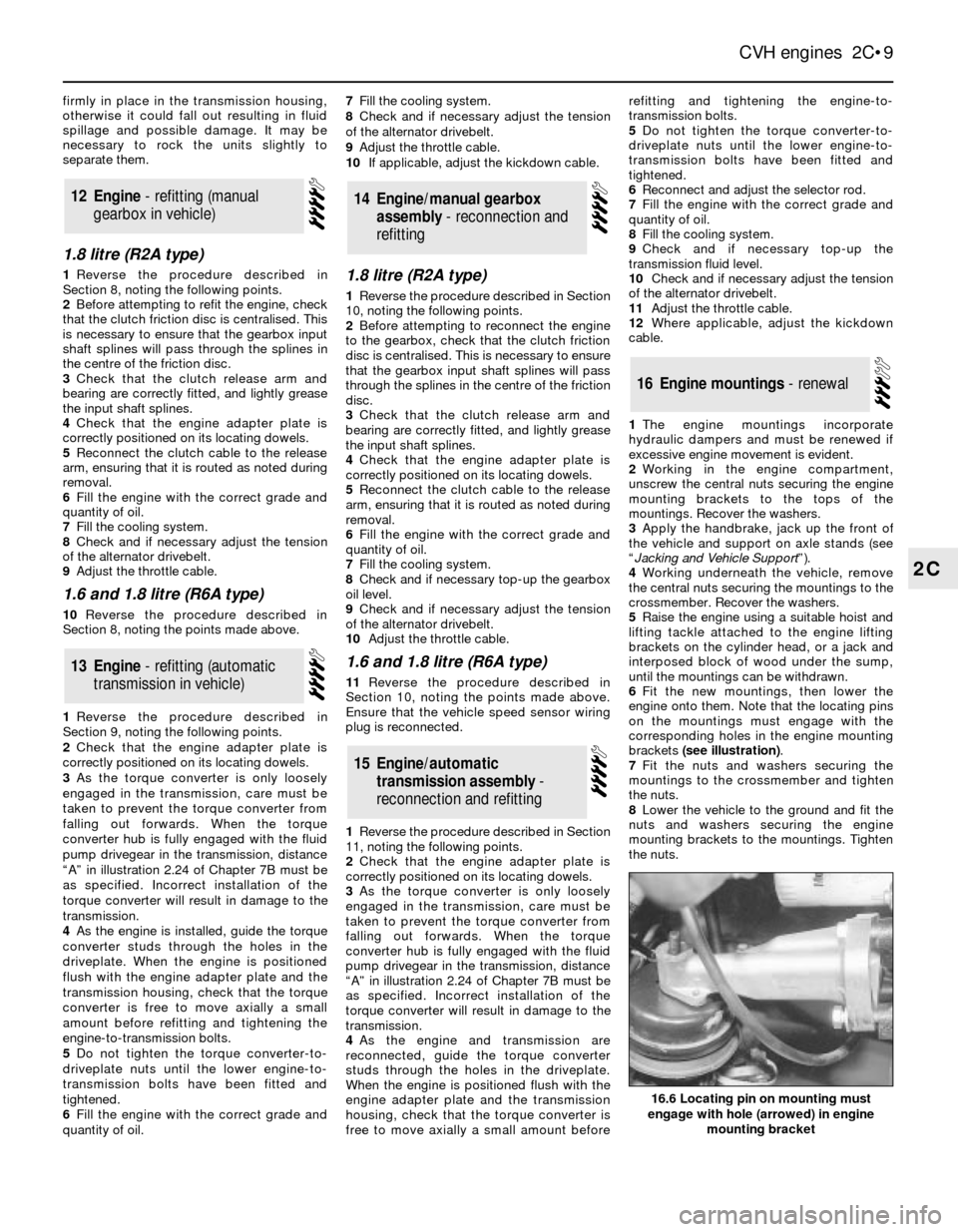
firmly in place in the transmission housing,
otherwise it could fall out resulting in fluid
spillage and possible damage. It may be
necessary to rock the units slightly to
separate them.
1.8 litre (R2A type)
1Reverse the procedure described in
Section 8, noting the following points.
2Before attempting to refit the engine, check
that the clutch friction disc is centralised. This
is necessary to ensure that the gearbox input
shaft splines will pass through the splines in
the centre of the friction disc.
3Check that the clutch release arm and
bearing are correctly fitted, and lightly grease
the input shaft splines.
4Check that the engine adapter plate is
correctly positioned on its locating dowels.
5Reconnect the clutch cable to the release
arm, ensuring that it is routed as noted during
removal.
6Fill the engine with the correct grade and
quantity of oil.
7Fill the cooling system.
8Check and if necessary adjust the tension
of the alternator drivebelt.
9Adjust the throttle cable.
1.6 and 1.8 litre (R6A type)
10Reverse the procedure described in
Section 8, noting the points made above.
1Reverse the procedure described in
Section 9, noting the following points.
2Check that the engine adapter plate is
correctly positioned on its locating dowels.
3As the torque converter is only loosely
engaged in the transmission, care must be
taken to prevent the torque converter from
falling out forwards. When the torque
converter hub is fully engaged with the fluid
pump drivegear in the transmission, distance
“A” in illustration 2.24 of Chapter 7B must be
as specified. Incorrect installation of the
torque converter will result in damage to the
transmission.
4As the engine is installed, guide the torque
converter studs through the holes in the
driveplate. When the engine is positioned
flush with the engine adapter plate and the
transmission housing, check that the torque
converter is free to move axially a small
amount before refitting and tightening the
engine-to-transmission bolts.
5Do not tighten the torque converter-to-
driveplate nuts until the lower engine-to-
transmission bolts have been fitted and
tightened.
6Fill the engine with the correct grade and
quantity of oil. 7Fill the cooling system.
8Check and if necessary adjust the tension
of the alternator drivebelt.
9Adjust the throttle cable.
10If applicable, adjust the kickdown cable.
1.8 litre (R2A type)
1Reverse the procedure described in Section
10, noting the following points.
2Before attempting to reconnect the engine
to the gearbox, check that the clutch friction
disc is centralised. This is necessary to ensure
that the gearbox input shaft splines will pass
through the splines in the centre of the friction
disc.
3Check that the clutch release arm and
bearing are correctly fitted, and lightly grease
the input shaft splines.
4Check that the engine adapter plate is
correctly positioned on its locating dowels.
5Reconnect the clutch cable to the release
arm, ensuring that it is routed as noted during
removal.
6Fill the engine with the correct grade and
quantity of oil.
7Fill the cooling system.
8Check and if necessary top-up the gearbox
oil level.
9Check and if necessary adjust the tension
of the alternator drivebelt.
10Adjust the throttle cable.
1.6 and 1.8 litre (R6A type)
11Reverse the procedure described in
Section 10, noting the points made above.
Ensure that the vehicle speed sensor wiring
plug is reconnected.
1Reverse the procedure described in Section
11, noting the following points.
2Check that the engine adapter plate is
correctly positioned on its locating dowels.
3As the torque converter is only loosely
engaged in the transmission, care must be
taken to prevent the torque converter from
falling out forwards. When the torque
converter hub is fully engaged with the fluid
pump drivegear in the transmission, distance
“A” in illustration 2.24 of Chapter 7B must be
as specified. Incorrect installation of the
torque converter will result in damage to the
transmission.
4As the engine and transmission are
reconnected, guide the torque converter
studs through the holes in the driveplate.
When the engine is positioned flush with the
engine adapter plate and the transmission
housing, check that the torque converter is
free to move axially a small amount beforerefitting and tightening the engine-to-
transmission bolts.
5Do not tighten the torque converter-to-
driveplate nuts until the lower engine-to-
transmission bolts have been fitted and
tightened.
6Reconnect and adjust the selector rod.
7Fill the engine with the correct grade and
quantity of oil.
8Fill the cooling system.
9Check and if necessary top-up the
transmission fluid level.
10Check and if necessary adjust the tension
of the alternator drivebelt.
11Adjust the throttle cable.
12Where applicable, adjust the kickdown
cable.
1The engine mountings incorporate
hydraulic dampers and must be renewed if
excessive engine movement is evident.
2Working in the engine compartment,
unscrew the central nuts securing the engine
mounting brackets to the tops of the
mountings. Recover the washers.
3Apply the handbrake, jack up the front of
the vehicle and support on axle stands (see
“Jacking and Vehicle Support”).
4Working underneath the vehicle, remove
the central nuts securing the mountings to the
crossmember. Recover the washers.
5Raise the engine using a suitable hoist and
lifting tackle attached to the engine lifting
brackets on the cylinder head, or a jack and
interposed block of wood under the sump,
until the mountings can be withdrawn.
6Fit the new mountings, then lower the
engine onto them. Note that the locating pins
on the mountings must engage with the
corresponding holes in the engine mounting
brackets (see illustration).
7Fit the nuts and washers securing the
mountings to the crossmember and tighten
the nuts.
8Lower the vehicle to the ground and fit the
nuts and washers securing the engine
mounting brackets to the mountings. Tighten
the nuts.
16Engine mountings - renewal
15Engine/automatic
transmission assembly -
reconnection and refitting
14Engine/manual gearbox
assembly - reconnection and
refitting
13Engine - refitting (automatic
transmission in vehicle)
12Engine - refitting (manual
gearbox in vehicle)
CVH engines 2C•9
2C
16.6 Locating pin on mounting must
engage with hole (arrowed) in engine
mounting bracket
Page 10 of 24
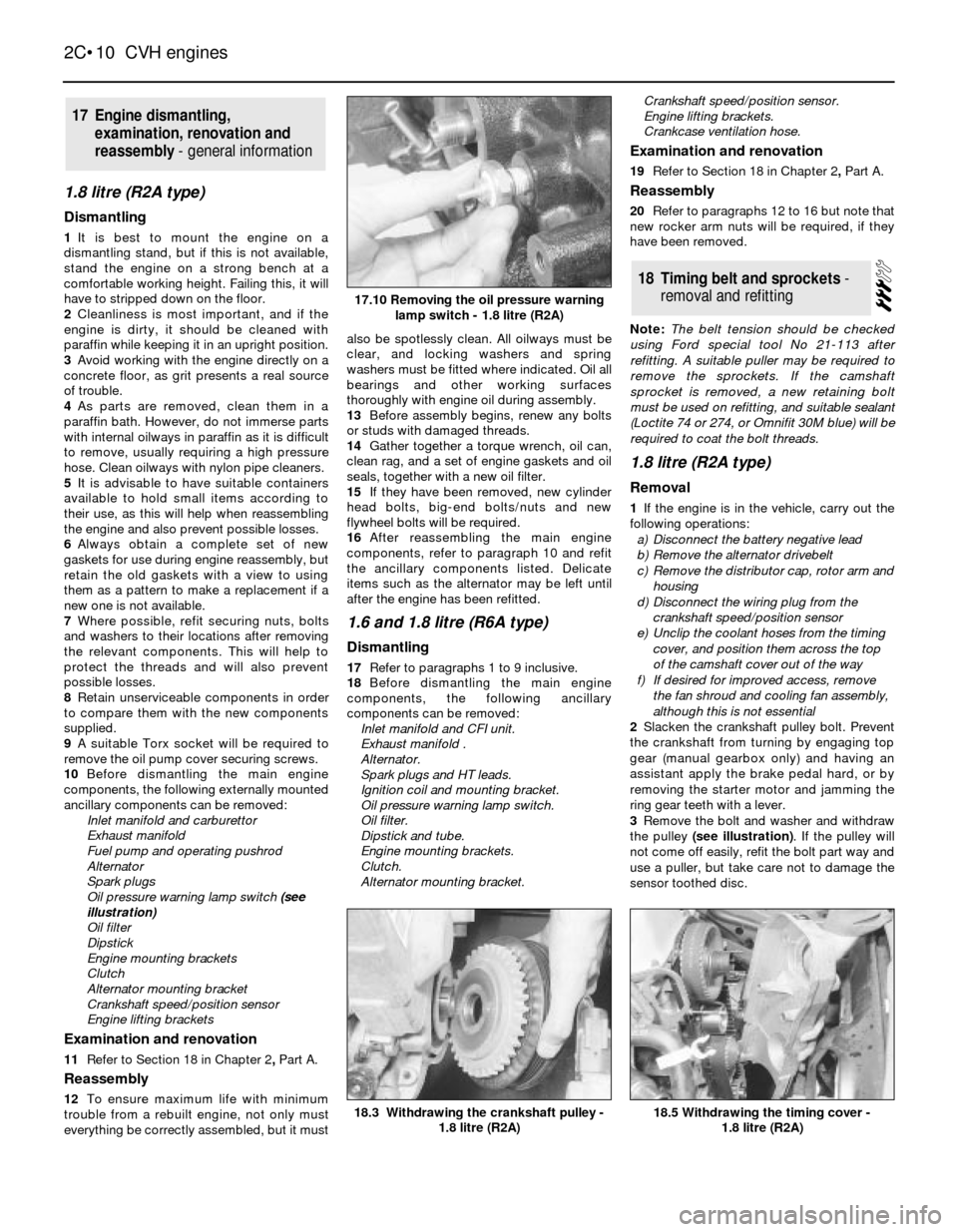
1.8 litre (R2A type)
Dismantling
1It is best to mount the engine on a
dismantling stand, but if this is not available,
stand the engine on a strong bench at a
comfortable working height. Failing this, it will
have to stripped down on the floor.
2Cleanliness is most important, and if the
engine is dirty, it should be cleaned with
paraffin while keeping it in an upright position.
3Avoid working with the engine directly on a
concrete floor, as grit presents a real source
of trouble.
4As parts are removed, clean them in a
paraffin bath. However, do not immerse parts
with internal oilways in paraffin as it is difficult
to remove, usually requiring a high pressure
hose. Clean oilways with nylon pipe cleaners.
5It is advisable to have suitable containers
available to hold small items according to
their use, as this will help when reassembling
the engine and also prevent possible losses.
6Always obtain a complete set of new
gaskets for use during engine reassembly, but
retain the old gaskets with a view to using
them as a pattern to make a replacement if a
new one is not available.
7Where possible, refit securing nuts, bolts
and washers to their locations after removing
the relevant components. This will help to
protect the threads and will also prevent
possible losses.
8Retain unserviceable components in order
to compare them with the new components
supplied.
9A suitable Torx socket will be required to
remove the oil pump cover securing screws.
10Before dismantling the main engine
components, the following externally mounted
ancillary components can be removed:
Inlet manifold and carburettor
Exhaust manifold
Fuel pump and operating pushrod
Alternator
Spark plugs
Oil pressure warning lamp switch (see
illustration)
Oil filter
Dipstick
Engine mounting brackets
Clutch
Alternator mounting bracket
Crankshaft speed/position sensor
Engine lifting brackets
Examination and renovation
11Refer to Section 18 in Chapter 2, PartA.
Reassembly
12To ensure maximum life with minimum
trouble from a rebuilt engine, not only must
everything be correctly assembled, but it mustalso be spotlessly clean. All oilways must be
clear, and locking washers and spring
washers must be fitted where indicated. Oil all
bearings and other working surfaces
thoroughly with engine oil during assembly.
13Before assembly begins, renew any bolts
or studs with damaged threads.
14Gather together a torque wrench, oil can,
clean rag, and a set of engine gaskets and oil
seals, together with a new oil filter.
15If they have been removed, new cylinder
head bolts, big-end bolts/nuts and new
flywheel bolts will be required.
16After reassembling the main engine
components, refer to paragraph 10 and refit
the ancillary components listed. Delicate
items such as the alternator may be left until
after the engine has been refitted.
1.6 and 1.8 litre (R6A type)
Dismantling
17Refer to paragraphs 1 to 9 inclusive.
18Before dismantling the main engine
components, the following ancillary
components can be removed:
Inlet manifold and CFI unit.
Exhaust manifold .
Alternator.
Spark plugs and HT leads.
Ignition coil and mounting bracket.
Oil pressure warning lamp switch.
Oil filter.
Dipstick and tube.
Engine mounting brackets.
Clutch.
Alternator mounting bracket.Crankshaft speed/position sensor.
Engine lifting brackets.
Crankcase ventilation hose.
Examination and renovation
19Refer to Section 18 in Chapter 2, PartA.
Reassembly
20Refer to paragraphs 12 to 16 but note that
new rocker arm nuts will be required, if they
have been removed.
Note: The belt tension should be checked
using Ford special tool No 21-113 after
refitting. A suitable puller may be required to
remove the sprockets. If the camshaft
sprocket is removed, a new retaining bolt
must be used on refitting, and suitable sealant
(Loctite 74 or 274, or Omnifit 30M blue) will be
required to coat the bolt threads.
1.8 litre (R2A type)
Removal
1If the engine is in the vehicle, carry out the
following operations:
a)Disconnect the battery negative lead
b)Remove the alternator drivebelt
c)Remove the distributor cap, rotor arm and
housing
d)Disconnect the wiring plug from the
crankshaft speed/position sensor
e)Unclip the coolant hoses from the timing
cover, and position them across the top
of the camshaft cover out of the way
f)If desired for improved access, remove
the fan shroud and cooling fan assembly,
although this is not essential
2Slacken the crankshaft pulley bolt. Prevent
the crankshaft from turning by engaging top
gear (manual gearbox only) and having an
assistant apply the brake pedal hard, or by
removing the starter motor and jamming the
ring gear teeth with a lever.
3Remove the bolt and washer and withdraw
the pulley (see illustration). If the pulley will
not come off easily, refit the bolt part way and
use a puller, but take care not to damage the
sensor toothed disc.
18Timing belt and sprockets -
removal and refitting
17Engine dismantling,
examination, renovation and
reassembly - general information
2C•10CVH engines
17.10 Removing the oil pressure warning
lamp switch - 1.8 litre (R2A)
18.5 Withdrawing the timing cover -
1.8 litre (R2A)18.3 Withdrawing the crankshaft pulley -
1.8 litre (R2A)
Page 12 of 24
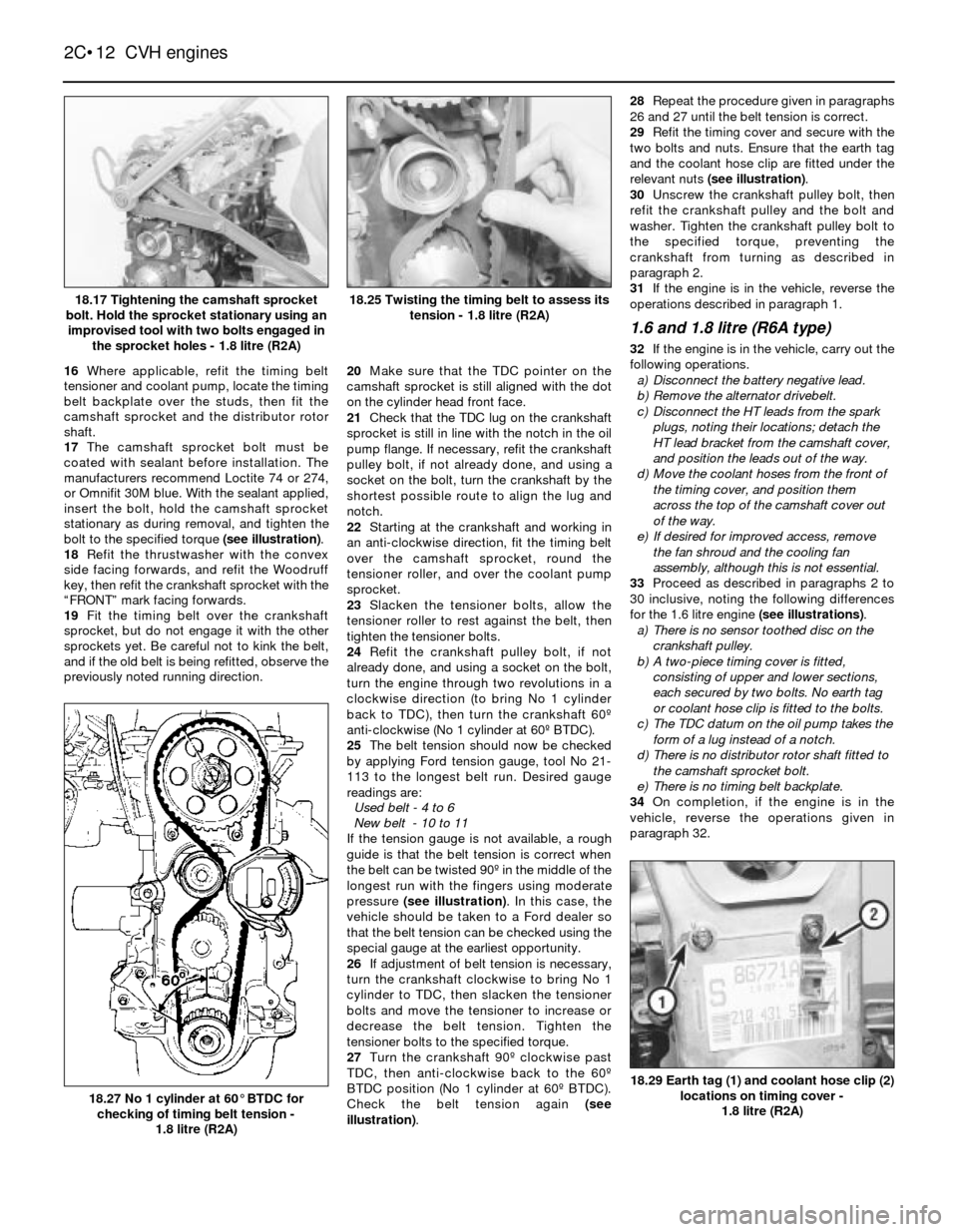
16Where applicable, refit the timing belt
tensioner and coolant pump, locate the timing
belt backplate over the studs, then fit the
camshaft sprocket and the distributor rotor
shaft.
17The camshaft sprocket bolt must be
coated with sealant before installation. The
manufacturers recommend Loctite 74 or 274,
or Omnifit 30M blue. With the sealant applied,
insert the bolt, hold the camshaft sprocket
stationary as during removal, and tighten the
bolt to the specified torque (see illustration).
18Refit the thrustwasher with the convex
side facing forwards, and refit the Woodruff
key, then refit the crankshaft sprocket with the
“FRONT” mark facing forwards.
19Fit the timing belt over the crankshaft
sprocket, but do not engage it with the other
sprockets yet. Be careful not to kink the belt,
and if the old belt is being refitted, observe the
previously noted running direction.20Make sure that the TDC pointer on the
camshaft sprocket is still aligned with the dot
on the cylinder head front face.
21Check that the TDC lug on the crankshaft
sprocket is still in line with the notch in the oil
pump flange. If necessary, refit the crankshaft
pulley bolt, if not already done, and using a
socket on the bolt, turn the crankshaft by the
shortest possible route to align the lug and
notch.
22Starting at the crankshaft and working in
an anti-clockwise direction, fit the timing belt
over the camshaft sprocket, round the
tensioner roller, and over the coolant pump
sprocket.
23Slacken the tensioner bolts, allow the
tensioner roller to rest against the belt, then
tighten the tensioner bolts.
24Refit the crankshaft pulley bolt, if not
already done, and using a socket on the bolt,
turn the engine through two revolutions in a
clockwise direction (to bring No 1 cylinder
back to TDC), then turn the crankshaft 60º
anti-clockwise (No 1 cylinder at 60º BTDC).
25The belt tension should now be checked
by applying Ford tension gauge, tool No 21-
113 to the longest belt run. Desired gauge
readings are:
Used belt - 4 to 6
New belt - 10 to 11
If the tension gauge is not available, a rough
guide is that the belt tension is correct when
the belt can be twisted 90º in the middle of the
longest run with the fingers using moderate
pressure (see illustration). In this case, the
vehicle should be taken to a Ford dealer so
that the belt tension can be checked using the
special gauge at the earliest opportunity.
26If adjustment of belt tension is necessary,
turn the crankshaft clockwise to bring No 1
cylinder to TDC, then slacken the tensioner
bolts and move the tensioner to increase or
decrease the belt tension. Tighten the
tensioner bolts to the specified torque.
27Turn the crankshaft 90º clockwise past
TDC, then anti-clockwise back to the 60º
BTDC position (No 1 cylinder at 60º BTDC).
Check the belt tension again (see
illustration).28Repeat the procedure given in paragraphs
26 and 27 until the belt tension is correct.
29Refit the timing cover and secure with the
two bolts and nuts. Ensure that the earth tag
and the coolant hose clip are fitted under the
relevant nuts (see illustration).
30Unscrew the crankshaft pulley bolt, then
refit the crankshaft pulley and the bolt and
washer. Tighten the crankshaft pulley bolt to
the specified torque, preventing the
crankshaft from turning as described in
paragraph 2.
31If the engine is in the vehicle, reverse the
operations described in paragraph 1.
1.6 and 1.8 litre (R6A type)
32If the engine is in the vehicle, carry out the
following operations.
a)Disconnect the battery negative lead.
b)Remove the alternator drivebelt.
c)Disconnect the HT leads from the spark
plugs, noting their locations; detach the
HT lead bracket from the camshaft cover,
and position the leads out of the way.
d)Move the coolant hoses from the front of
the timing cover, and position them
across the top of the camshaft cover out
of the way.
e)If desired for improved access, remove
the fan shroud and the cooling fan
assembly, although this is not essential.
33Proceed as described in paragraphs 2 to
30 inclusive, noting the following differences
for the 1.6 litre engine (see illustrations).
a)There is no sensor toothed disc on the
crankshaft pulley.
b)A two-piece timing cover is fitted,
consisting of upper and lower sections,
each secured by two bolts. No earth tag
or coolant hose clip is fitted to the bolts.
c)The TDC datum on the oil pump takes the
form of a lug instead of a notch.
d)There is no distributor rotor shaft fitted to
the camshaft sprocket bolt.
e)There is no timing belt backplate.
34On completion, if the engine is in the
vehicle, reverse the operations given in
paragraph 32.
2C•12CVH engines
18.17 Tightening the camshaft sprocket
bolt. Hold the sprocket stationary using an
improvised tool with two bolts engaged in
the sprocket holes - 1.8 litre (R2A)
18.27 No 1 cylinder at 60°BTDC for
checking of timing belt tension -
1.8 litre (R2A)
18.29 Earth tag (1) and coolant hose clip (2)
locations on timing cover -
1.8 litre (R2A)
18.25 Twisting the timing belt to assess its
tension - 1.8 litre (R2A)
Page 14 of 24
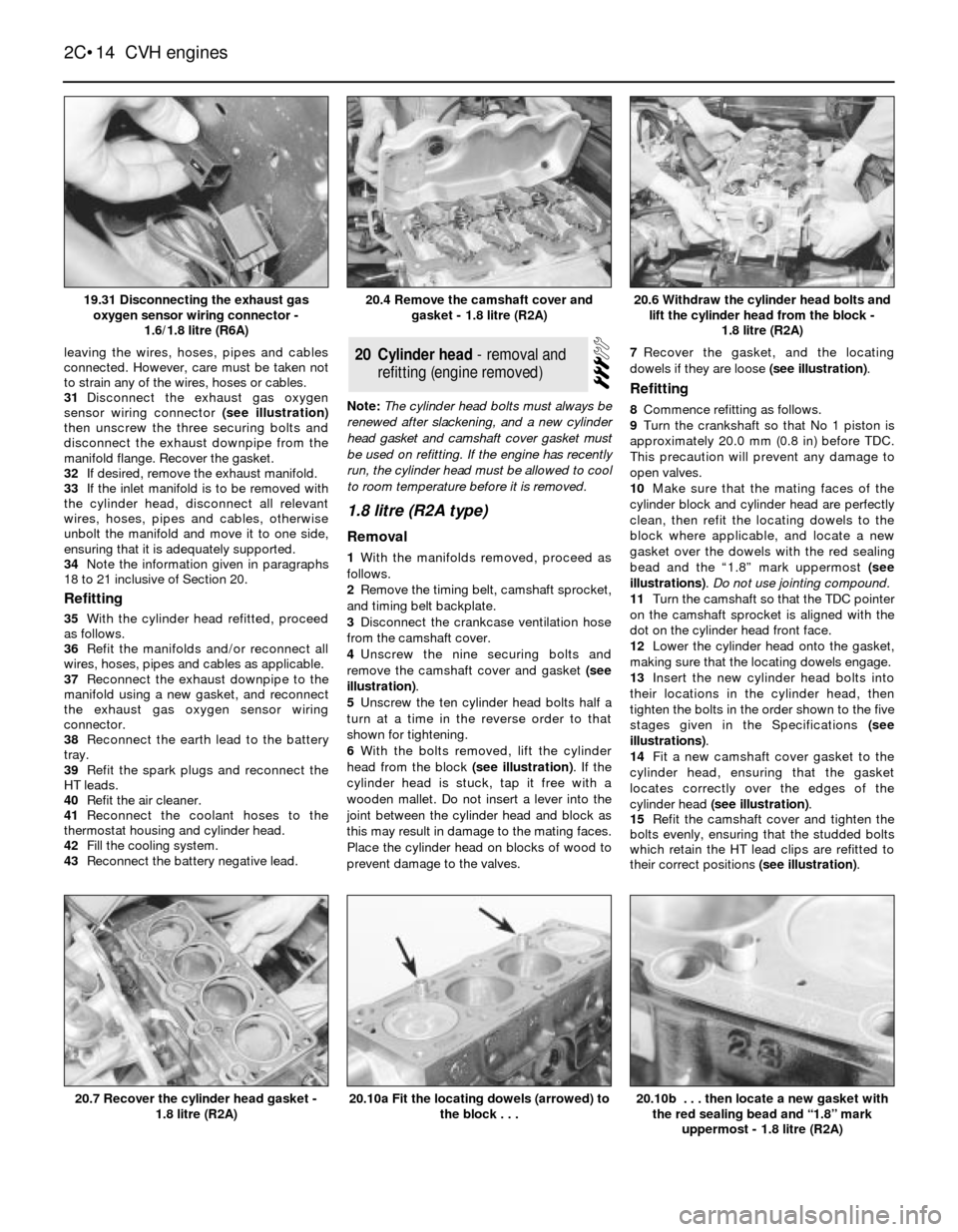
leaving the wires, hoses, pipes and cables
connected. However, care must be taken not
to strain any of the wires, hoses or cables.
31Disconnect the exhaust gas oxygen
sensor wiring connector (see illustration)
then unscrew the three securing bolts and
disconnect the exhaust downpipe from the
manifold flange. Recover the gasket.
32If desired, remove the exhaust manifold.
33If the inlet manifold is to be removed with
the cylinder head, disconnect all relevant
wires, hoses, pipes and cables, otherwise
unbolt the manifold and move it to one side,
ensuring that it is adequately supported.
34Note the information given in paragraphs
18 to 21 inclusive of Section 20.
Refitting
35With the cylinder head refitted, proceed
as follows.
36Refit the manifolds and/or reconnect all
wires, hoses, pipes and cables as applicable.
37Reconnect the exhaust downpipe to the
manifold using a new gasket, and reconnect
the exhaust gas oxygen sensor wiring
connector.
38Reconnect the earth lead to the battery
tray.
39Refit the spark plugs and reconnect the
HT leads.
40Refit the air cleaner.
41Reconnect the coolant hoses to the
thermostat housing and cylinder head.
42Fill the cooling system.
43Reconnect the battery negative lead.Note: The cylinder head bolts must always be
renewed after slackening, and a new cylinder
head gasket and camshaft cover gasket must
be used on refitting. If the engine has recently
run, the cylinder head must be allowed to cool
to room temperature before it is removed.
1.8 litre (R2A type)
Removal
1With the manifolds removed, proceed as
follows.
2Remove the timing belt, camshaft sprocket,
and timing belt backplate.
3Disconnect the crankcase ventilation hose
from the camshaft cover.
4Unscrew the nine securing bolts and
remove the camshaft cover and gasket (see
illustration).
5Unscrew the ten cylinder head bolts half a
turn at a time in the reverse order to that
shown for tightening.
6With the bolts removed, lift the cylinder
head from the block (see illustration). If the
cylinder head is stuck, tap it free with a
wooden mallet. Do not insert a lever into the
joint between the cylinder head and block as
this may result in damage to the mating faces.
Place the cylinder head on blocks of wood to
prevent damage to the valves.7Recover the gasket, and the locating
dowels if they are loose (see illustration).
Refitting
8Commence refitting as follows.
9Turn the crankshaft so that No 1 piston is
approximately 20.0 mm (0.8 in) before TDC.
This precaution will prevent any damage to
open valves.
10Make sure that the mating faces of the
cylinder block and cylinder head are perfectly
clean, then refit the locating dowels to the
block where applicable, and locate a new
gasket over the dowels with the red sealing
bead and the “1.8” mark uppermost (see
illustrations). Do not use jointing compound.
11Turn the camshaft so that the TDC pointer
on the camshaft sprocket is aligned with the
dot on the cylinder head front face.
12Lower the cylinder head onto the gasket,
making sure that the locating dowels engage.
13Insert the new cylinder head bolts into
their locations in the cylinder head, then
tighten the bolts in the order shown to the five
stages given in the Specifications (see
illustrations).
14Fit a new camshaft cover gasket to the
cylinder head, ensuring that the gasket
locates correctly over the edges of the
cylinder head (see illustration).
15Refit the camshaft cover and tighten the
bolts evenly, ensuring that the studded bolts
which retain the HT lead clips are refitted to
their correct positions (see illustration).
20Cylinder head - removal and
refitting (engine removed)
2C•14CVH engines
19.31 Disconnecting the exhaust gas
oxygen sensor wiring connector -
1.6/1.8 litre (R6A)20.6 Withdraw the cylinder head bolts and
lift the cylinder head from the block -
1.8 litre (R2A)
20.10b . . . then locate a new gasket with
the red sealing bead and “1.8” mark
uppermost - 1.8 litre (R2A)20.10a Fit the locating dowels (arrowed) to
the block . . .20.7 Recover the cylinder head gasket -
1.8 litre (R2A)
20.4 Remove the camshaft cover and
gasket - 1.8 litre (R2A)
Page 19 of 24
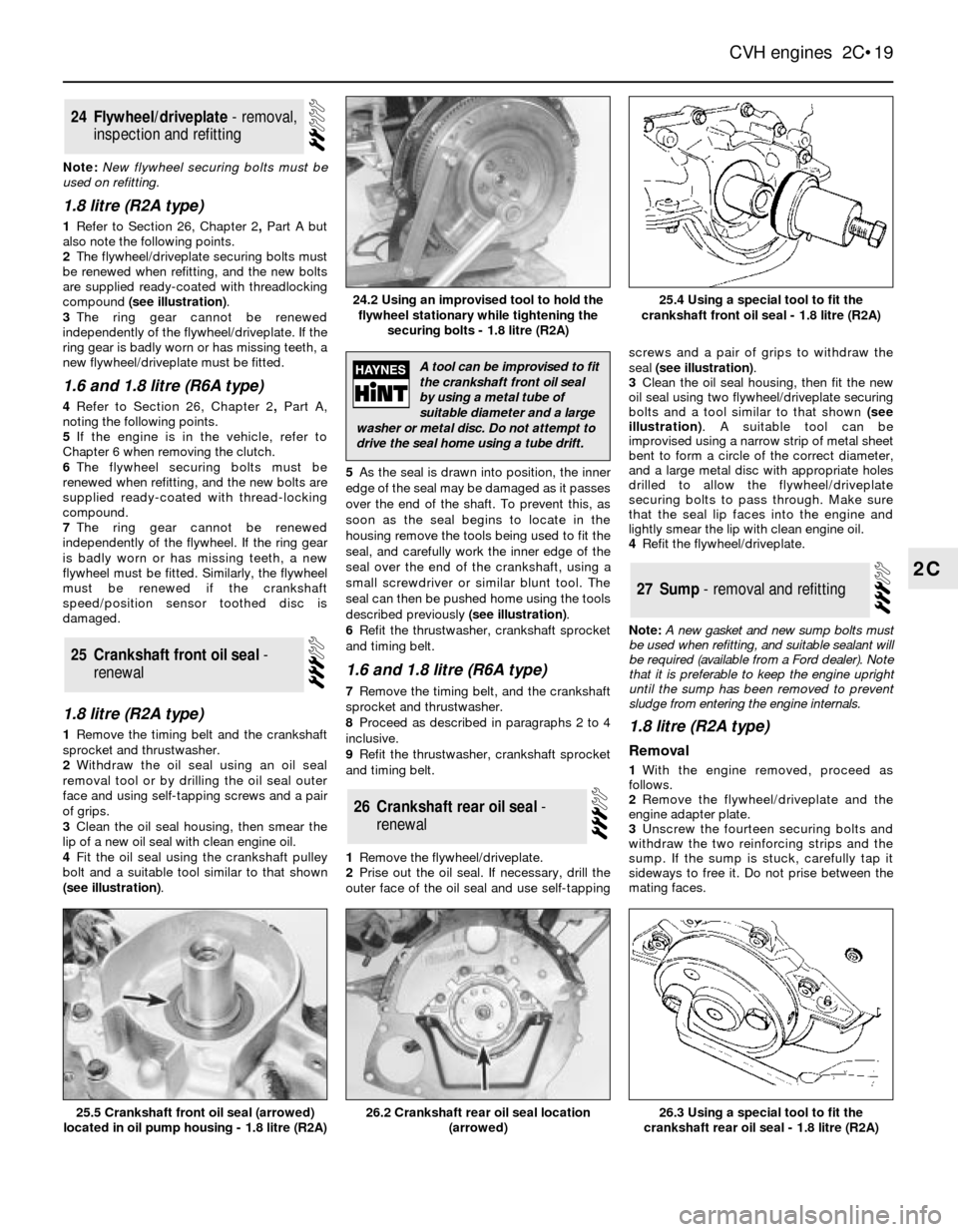
Note: New flywheel securing bolts must be
used on refitting.
1.8 litre (R2A type)
1Refer to Section 26, Chapter 2, PartA but
also note the following points.
2The flywheel/driveplate securing bolts must
be renewed when refitting, and the new bolts
are supplied ready-coated with threadlocking
compound (see illustration).
3The ring gear cannot be renewed
independently of the flywheel/driveplate. If the
ring gear is badly worn or has missing teeth, a
new flywheel/driveplate must be fitted.
1.6 and 1.8 litre (R6A type)
4Refer to Section 26, Chapter 2, PartA,
noting the following points.
5If the engine is in the vehicle, refer to
Chapter 6 when removing the clutch.
6The flywheel securing bolts must be
renewed when refitting, and the new bolts are
supplied ready-coated with thread-locking
compound.
7The ring gear cannot be renewed
independently of the flywheel. If the ring gear
is badly worn or has missing teeth, a new
flywheel must be fitted. Similarly, the flywheel
must be renewed if the crankshaft
speed/position sensor toothed disc is
damaged.
1.8 litre (R2A type)
1Remove the timing belt and the crankshaft
sprocket and thrustwasher.
2Withdraw the oil seal using an oil seal
removal tool or by drilling the oil seal outer
face and using self-tapping screws and a pair
of grips.
3Clean the oil seal housing, then smear the
lip of a new oil seal with clean engine oil.
4Fit the oil seal using the crankshaft pulley
bolt and a suitable tool similar to that shown
(see illustration).5As the seal is drawn into position, the inner
edge of the seal may be damaged as it passes
over the end of the shaft. To prevent this, as
soon as the seal begins to locate in the
housing remove the tools being used to fit the
seal, and carefully work the inner edge of the
seal over the end of the crankshaft, using a
small screwdriver or similar blunt tool. The
seal can then be pushed home using the tools
described previously (see illustration).
6Refit the thrustwasher, crankshaft sprocket
and timing belt.
1.6 and 1.8 litre (R6A type)
7Remove the timing belt, and the crankshaft
sprocket and thrustwasher.
8Proceed as described in paragraphs 2 to 4
inclusive.
9Refit the thrustwasher, crankshaft sprocket
and timing belt.
1Remove the flywheel/driveplate.
2Prise out the oil seal. If necessary, drill the
outer face of the oil seal and use self-tappingscrews and a pair of grips to withdraw the
seal (see illustration).
3Clean the oil seal housing, then fit the new
oil seal using two flywheel/driveplate securing
bolts and a tool similar to that shown (see
illustration). A suitable tool can be
improvised using a narrow strip of metal sheet
bent to form a circle of the correct diameter,
and a large metal disc with appropriate holes
drilled to allow the flywheel/driveplate
securing bolts to pass through. Make sure
that the seal lip faces into the engine and
lightly smear the lip with clean engine oil.
4Refit the flywheel/driveplate.
Note: A new gasket and new sump bolts must
be used when refitting, and suitable sealant will
be required (available from a Ford dealer). Note
that it is preferable to keep the engine upright
until the sump has been removed to prevent
sludge from entering the engine internals.
1.8 litre (R2A type)
Removal
1With the engine removed, proceed as
follows.
2Remove the flywheel/driveplate and the
engine adapter plate.
3Unscrew the fourteen securing bolts and
withdraw the two reinforcing strips and the
sump. If the sump is stuck, carefully tap it
sideways to free it. Do not prise between the
mating faces.
27Sump - removal and refitting
26Crankshaft rear oil seal -
renewal
25Crankshaft front oil seal -
renewal
24Flywheel/driveplate - removal,
inspection and refitting
CVH engines 2C•19
2C
25.5 Crankshaft front oil seal (arrowed)
located in oil pump housing - 1.8 litre (R2A)26.3 Using a special tool to fit the
crankshaft rear oil seal - 1.8 litre (R2A)26.2 Crankshaft rear oil seal location
(arrowed)
25.4 Using a special tool to fit the
crankshaft front oil seal - 1.8 litre (R2A)24.2 Using an improvised tool to hold the
flywheel stationary while tightening the
securing bolts - 1.8 litre (R2A)
A tool can be improvised to fit
the crankshaft front oil seal
by using a metal tube of
suitable diameter and a large
washer or metal disc. Do not attempt to
drive the seal home using a tube drift.